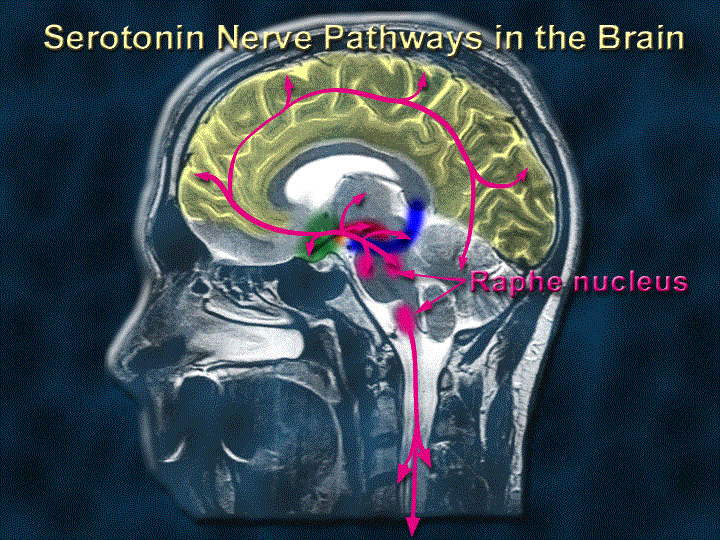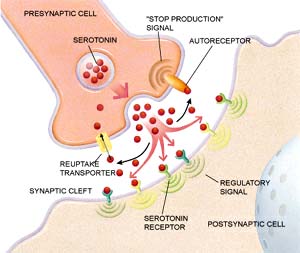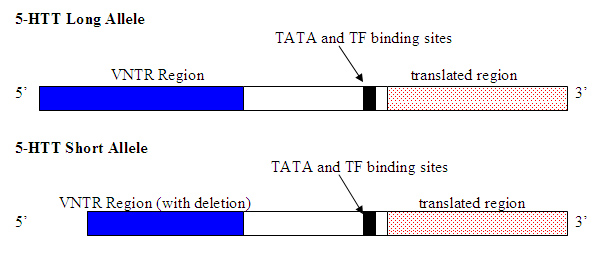This web page was produced as an assignment for an undergraduate
course at Davidson College.
5-HTT: The Gene for Susceptibility to Depression?
A recent scientific paper and a corresponding popular press report announced that mutations in the 5-HTT gene moderate a person's likelihood to experience depression after stressful events (Caspi et. al., 2003). The link between 5-HTT and mood disorders is thought to be related to the protein product's role as a serotonin transporter. Further research shows that this gene's association with many human problems, such as binge drinking, suicide, autism, and panic disorders, has been studied for many years.
Scientific Study and Press Report: A Gene that Determines Depression After Stress
Why do individuals become depressed? It is evident that depression is a multifactorial phenomenon, and stressful or traumatic situations often play a role. So, why do some individuals easily become depressed after such events and others do not? In July, 2003, an article in the New York Times reported on a corresponding article in Science magazine that claimed to identify a genetic factor moderating this susceptibility to depression after stress. Both articles discuss results which indicate that individuals with one or two short alleles of the 5-HTT serotonin transporter gene become depressed more often after stressful events than individuals with two long alleles of this gene (Caspi, et. al., 2003). In general, the popular press report on this research is less detailed and presented in a more simplified manner, but both articles contain similar conclusions. |
 Image from: http://www-dateline.ucdavis.edu/010700/DL_depression.html Permission Pending. |
Background: The Serotonin Pathway and its Transporter
About 18.8 million American adults suffer diagnosed depression each year. Clinically diagnosed "major depression" (the type considered in this research) is characterized by symptoms including persistent sadness, extreme fatigue, feelings of guilt and hopelessness, appetite loss, insomnia, and suicidal thoughts. In major depression, these symptoms become debilitating and prevent normal life activities (NIMH, 2003). This study specifically investigates the genetic influences on episodes of this major depression after stress.
Both the popular press and scientific articles that cite 5-HTT as a gene moderating susceptibility to depression discuss briefly the previous studies of this gene. The 5-HTT gene encodes the serotonin transporter protein and is thus active in the serotonin nerve pathways. Scientists have long known that these pathways are involved in controlling mood, emotions, aggression, sleep, and anxiety. (NIDA, 2003). The figure below gives a general view of the various areas in the brain affected by the serotonin pathways.

Figure 1. Serotonin Pathways in the Brain. This image shows the areas in the brain in which serotonin is active. Image from: http://www.drugabuse.gov/pubs/teaching/teaching4/Teaching3.html Permission Pending.
As a serotonin transporter, the protein encoded by the 5-HTT gene is responsible for the reuptake of serotonin into the presynaptic cell after it has been released into the synaptic cleft to signal the adjacent neuron. The precise structure of this protein has not been determined, but it is known to be located in the presynaptic cell membrane. The activity and number of the serotonin transporter proteins determine the length of time that the chemical signal remains in the synapse (Glatz, et. al. 2003). This basic process is shown in the image below.

Figure 2. Diagram of the action of Serotonin and the Serotonin Transporter. This diagram shows the neurotransmitter serotonin being released from the presynaptic cell and binding to the receptors on the postsynaptic cell. 5-HTT encodes the protein labeled "reuptake transporter." Image from http://psychclerk.bsd.uchicago.edu/lect_depression.html Permission Pending.
Since the serotonin pathway, and specifically the serotonin transporter, are involved in mood control, multiple antidepressant medications have targeted these elements, and researchers have often studied the 5-HTT transporter for its role in depression. The NY Times article mentions some previous research with this gene, presenting the previous studies as logical and supportive steps that preceeded this research. The article cites studies that associated the 5-HTT gene with anxiety in monkeys and mice and later studies that correlated the presence of the short allele with human anxiety after exposure to disturbing images. (Duenwald, 2003). The science article mentions similar studies, but with the caveat that these previous studies do not produce conclusive evidence for the link between 5-HTT and depression and acknowledging that some studies had in fact found no association between the this gene and depression (Caspi, et. al. 2003).
Polymorphism in 5-HTT
The NY Times article states that while the alleles of the 5-HTT gene are called "short" and "long," the protein that they produce is the same- the long allele just produces more of the protein. The article in Science explains this phenomenon by clarifying that the polymorphism actually does not occur within the open reading frame of the 5-HTT gene itself, but in the 5' regulatory region. Thus, the terms "short" and "long" actually refer to two different lengths of the sequences in the gene's regulatory region, as shown in the image below.

Figure 3. Simplified Diagram of 5-HTT gene associated region polymorphism. This diagram shows the two alleles of the 5-HTT gene region. The transcription factor binding sites and actual translated region of the gene are identical, but the alleles differ in the 5' repeat (VNTR) region. Image idea from Glatz et. al., 2003.
The 44 bp deletion in the regulatory section of the 5-HTT "short" (s) allele occurs 1 kb upstream of the transcription initiation site of the gene (OMIM, 2003). It might seem reasonable to omit this detailed scientific information from the popular press article, but this detail is important in that it contradicts a popular misconception that only mutations within the coding genes themselves can cause diseases and disorders. In fact, an earlier study showed that mutations within the coding region of the 5-HTT gene itself are not related to mood disorders. (Di Bella et. al., 1996).
The polymorphism causes decreased gene expression and fewer serotonin transporters in the membrane of the cell. Thus, rate of reuptake of serotonin is reduced. This research tries to correlate this phenomenon with the development of depression. (Caspi et. al., 2003).
Methods of Research
In the human population, the frequency of the long allele of 5-HTT is about 57% that of the short allele is 43% (OMIM, 2003). The study described in these articles follows a cohort of individuals with varying genotypes for the 5-HTT gene. When the subjects were 26 years old, the researchers evaluated whether or not the subjects had experienced one or multiple stressful events and then whether or not they developed depression. Depression after stress was then related to the subjects' genotypes. Both articles state the results that individuals having two short forms of the gene were most likely to be depressed after stressful events, individuals with one long and one short form were moderately likely to be depressed, and those with two long alleles typically responded as if no stressful events had occurred (Duenwald, 2003).
Though the results presented in the two articles are similar, important differences occur, expectedly, in the amount of detail provided about the methods and data. The NY Times article states the conclusions without supporting data, while the scientific article allows evaluation of the specific methods and data. Consideration of these features may lead to additional caveats that must be considered. One such qualification is that the researchers focused on stressful events occurring after age 21 and depression diagnosed after age 21. Thus, the predictive value of the gene at younger ages would require more study. This scientific article also details the specific facets of depression- self reported depression, clincially diagnosed major depression, and suicidal thoughts or attempts- that were well correlated with the presence of a 5-HTT short allele, rather than simply making the statemtent that "depression" was related to this allele (Caspi, et. al. 2003).
Conclusions: Can 5-HTT Be Used in Diagnosis and Treatment?
After presenting similar results, both articles also present similar conclusions. As would be expected for a popular press article, the NY Times focuses on the ability to use these findings in practical applications- specifically the ability to predict depression. The article expressed hope that analysis of this gene could be used to predict who will suffer depression "about as well as a bone mineral density test can predict who will suffer a fractured hip." Though the popular article included the qualification that this study would have to be further verified before many applications could be developed, the conclusion was quite optimistic (Duenwald, 2003). The scientific article was similarly hopeful that these results demonstrated a useful correlation between the gene and phenotype of depression, but the authors noted the possible effects of other genes on the mood pathways and stated that "speculation about clinical implications is premature"- a much more cautious conclusion than that presented by the popular press. The scientific article also stresses the importance of this study in its demonstration that genetic factors may not directly "cause" disease, but instead moderate responses to environmental factors (Caspi, et. al. 2003). This is another important subtlety that is often missed by the popular press.
Though 5-HTT may be predictive of susceptibility to depression after stress, casual readers might be tempted to think that this gene and pathway could therefore be easily targeted for treatment. The article from Science states that the correlation between 5-HTT and reaction to stress seen in this study provides encouraging evidence that further study of 5-HTT could lead to better treatments (Caspi, et. al. 2003). This may be true, but the mention of treatments reveals an important gap in understanding of the serotonin pathway and its precise effect on moods. As both articles mention, successful treatment of depression has often involved serotonin reuptake inhibitors, yet decreased expression of 5-HTT, the transporter responsible for this reuptake, seems to exacerbate depression after stressful conditions. Contradictory evidence like this must be evaluated further before any better treatments can be developed.
Complexity: Other Genes
Other reasons that this gene cannot be specifically targeted as an effective treatment for depression include the fact that many other genes are involved in depression. Though none are mentioned in the NY Times article, the Science article does note at least one other genes that has been related to reactions to stress. For example, the gene encoding the monoamine oxidase A (MAOA) has been correlated to children's reaction to maltreatment (Caspi, et. al., 2003). Other research has shown that the 5-HTT gene is influenced not only by its 5' associated region in which the polymorphism occurs, but also by factors such as glucocorticosteroid hormones, even further complicating the pathways influencing depression (Glatz, et. al., 2003).
More Complexity: Other Traits Linked to 5-HTT
In modern society, there are many reports of a gene being found to explain certain diseases and traits. Often these reports are overly simplistic and communicate an incomplete view of genes to the public. Both of these articles conclude that the 5-HTT gene is an important factor in mediating and predicting the human response to stress, but do not claim that this gene "causes" depression. Though this avoids some of the common oversimplification, both of these articles fail to mention the fact that the 5-HTT gene has been and continues to be studied for its role in a wide variety of traits. The "one gene, one phenotype" model certainly does not hold in this case as one might think from reading these articles. Soon after this study was published, Science and popular press sources published articles reviewing a study of the 5-HTT gene as the "gene for campus drinking" (Herman et. al., 2003 and Griffin, 2003). Just as the presence of the short allele was correlated to increased depression after stress, college students homozygous for the short allele were found to be more likely to binge drink.
A search of PubMed for "5-HTT" reveals many other conditions that have been linked to this gene. Researchers have investigated its role in autism, attention deficit hyperactive disorder (ADHD), sudden infant death syndrome, aggressiveness in Alzheimer's, bipolar disorder, panic disorders, auditory processing disorders, susceptibility to cocaine dependence, and suicidal behavior. Further complexity is added by the fact that in some of these cases, the long allele appears to be the "mutant," causing the abnormal phenotype, while the short allele (which in the case of depression after stress relates to the unwanted symptoms) appears to be wild type. For example, the large numbers of serotonin transporters produced in Alzheimer's patients with two long 5-HTT alleles seemed to contribute to increased anxiety for these individuals (Tsang, SW et. al., 2003) .
All of the studies of the 5-HTT gene, including this one linking it to depression after stress, indicate that this serotonin transporter and serotonin pathway in general is worthy of further study. Studies such as this one can provide convincing and useful evidence that polymorphisms in certain genes are linked with human disorders or conditions. However, before the popular press or scientific sources are tempted to state that a gene like 5-HTT is "the autism gene" or "the response to stress gene," the diverse effects of the gene and the complexity of the pathways in which its protein acts must be fully considered.
Links
5-HTT Gene Sequence- The sequence of the complete cDNA of the 5-HTT gene is found at the bottom of this page.
Serotonin Transporter Protein Sequence- This page gives the complete amino acid sequence for the 5-HTT encoded serotonin transporter protein.
National Institute of Mental Health- This website provides a wide range of information about mental health disorders, including much information about depression. In addition to providing information about recent research, including the Science article about the genetics of depression after stress, this website provides information for depressed individuals, their families, practicioners, and the general public.
References
Caspi A et. al. 2003. Influence of Life Stress on Depression: Moderation in the 5-HTT Gene. Science 301: 386-389.
Di Bella, D. et. al. 1996. Systematic screening for mutations in the coding region of the human serotonin transporter (5-HTT) gene using PCR and DGGE. Am J Med Genet. 67: 541-5.
Duenwald M. 2003. Gene is Linked to Susceptibility to Depression. The New York Times. July, 18 2003. <http://query.nytimes.com/gst/abstract.html?res=F00712FC3B580C7B8DDDAE0894DB404482> Accessed 2003 28 Aug.
Glatz, K et. al. 2003. Glucocorticoid-regulated human serotonin transporter (5-HTT) expression is modulated by the 5-HTT gene-promotor-linked polymorphic region. Journal of Neurochemistry 86: 1072-1078.
Griffin, KL. 2003. Campus: Drinking Linked to Gene. The Oklahoma Daily. August 29, 2003. <http://www.oudaily.com/vnews/display.v/ART/2003/08/29/3f4eaf80160db> Accessed 2003 5 Sep.
Herman AI et.al. 2003. Serotonin Transporter Promoter Polymorphism and Differences in Alcohol Consumption Behavior in a College Student Population. Alcohol and Alcoholism 38: 446-449.
Klauck SM et. al. 1997. Serotonin transporter (5-HTT) gene variants associated with autism? Human Molecular Genetics 6: 2233-8. <http://hmg.oupjournals.org/cgi/content/full/6/13/2233> Accessed 2003 5 Sep.
National Institute of Mental Health (NIMH). 2003. Depression. <http://www.nimh.nih.gov/publicat/depression.cfm> Accessed 2003 15 Sep.
National Institute on Drug Abuse (NIDA). 2003. The Neurobiology of Ecstasy. <http://www.drugabuse.gov/pubs/teaching/teaching4/Teaching3.html> Accessed 2003 14 Sep.
Online Mendelian Inheritance in Man, OMIM (TM). Johns Hopkins University, Baltimore, MD. MIM Number: 182138: 2003 Aug. 15. World Wide Web URL <http://www.ncbi.nlm.nih.gov/omim/>
Tsang, SW et. al. 2003. Serotonin transporters are preserved in the neocortex of anxious Alzheimer's patients. Neuroreport, 14: 1297-1300.
Questions or Comments? Please e-mail Rachel Patton McCord
Rachel Patton McCord's Genomics Homepage